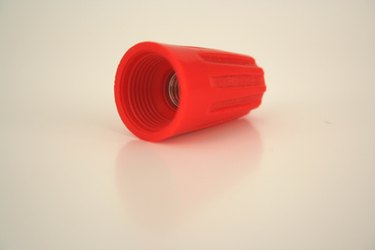
Photocells are basically a type of current resistor. When energy in the form of light strikes the cell, it allows current to flow at decreased resistance. As the light fades, the current flow dramatically and quickly diminishes. Photocells are programmable in that they can be calibrated to use for specific applications with differing shades of darkness. Photocells are complex systems with complex functions, so troubleshooting them must be done by isolating and examining one component at a time.
Step 1
Disconnect each photocell and motion sensor from the terminals to determine if the photocell is functioning properly. Relocate the photocell to the controller and hook it directly to the controller terminals.
Video of the Day
Step 2

Wrap the photocell with black electrician tape to mimic darkness. Set an experimental program on the controller to come on in 3 to 5 minutes. Program it to cut off in 5. minutes.
Step 3
Remove the tape from the photocell if the lights come on, then the lights should go off. Repeat several times. Eliminate photocell malfunction and move to the next component. If the lights do go off and come on correctly, that is proof the photocell is working as it should.
Step 4
Repeat the process four or five times if the light does not come on. Confirm the light is not coming on before concluding the photocell is bad. Replace the photocell only after making sure it is not functioning properly.
Step 5
Watch the lights to see if they do any of the following: come on and go off repeatedly, remain on regardless of tape coverage or not or do anything other than what is normal for a correctly working photocell. If the lights continue to function oddly, replace the photocell, but only after repeating the tape cover and removal experiment several times.
Step 6

Re-install the photocell and connect all wires to the controller. Repeat steps 2, 3, 4 and 5 to check its function once it is hooked back up. Do the test several times. If the photocell is performing normally, you will know that the photocell and its wiring are not the problem. However, if the photocell misbehaves while connected to the wires, then the wires need replaced.
Step 7
Test the motion sensor next with the same process. Take all the motion sensors and photo cell from the controller terminals. Remove the motion sensor from its present position and attach it directly to the controller terminals, one sensor at a time.
Step 8
Turn the motion sensor away from your body and any other nearby obstruction. Follow the programming manual and set the sensor for a 1-minute duration time. Wave your hand in front of the sensor in a full motion across the sensor field of vision.
Step 9
Wait a minute for the lights to come on. Repeat while watching to see if the sensor continues to perform correctly. If it does, you know the sensor is good. Reconnect it to the wiring and repeat the same steps used for the photocell diagnosis.
Video of the Day